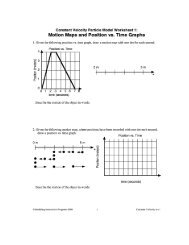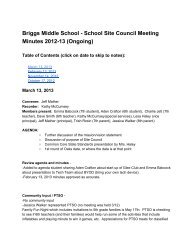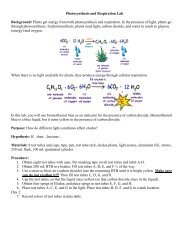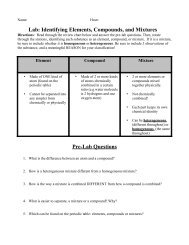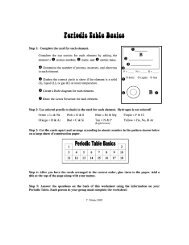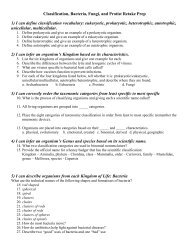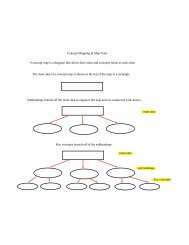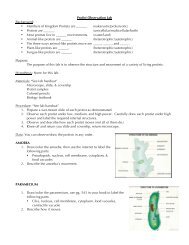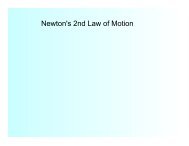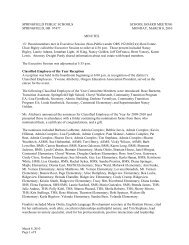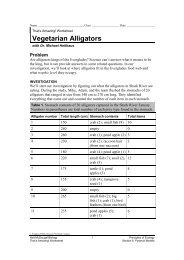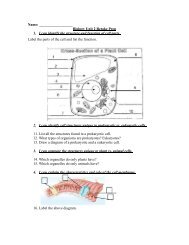Guidelines for Writing Good Descriptions
Guidelines for Writing Good Descriptions
Guidelines for Writing Good Descriptions
Create successful ePaper yourself
Turn your PDF publications into a flip-book with our unique Google optimized e-Paper software.
<strong>Guidelines</strong> <strong>for</strong> <strong>Writing</strong> <strong>Good</strong> <strong>Descriptions</strong><br />
Organization<br />
* OVERVIEW. Begin with a brief overview that reveals the object's<br />
(a) overall framework, arrangement, or shape, and<br />
(b) purpose or function.<br />
* PARTS. Divide the object into parts and describe each part<br />
(a) in enough detail to use, make, or draw it, and<br />
(b) in a way that reveals its role, its relation to other parts.<br />
* ORDER. Organize the part descriptions to help your reader:<br />
(a) spatial order (top to bottom, outside to inside), or<br />
(b) priority order (most to least important), or<br />
(c) chronological order (order of [dis]assembly).<br />
Content<br />
* SPECIFICS.<br />
o Include relevant specific features (such as size, shape, color, material, technical names).<br />
o Omit irrelevant background, confusing details, and needless words.<br />
* COMPARISON. Compare features or parts with other things already familiar.<br />
* CONTRAST. Contrast properties with different ones to reveal their significance.<br />
Signals <strong>for</strong> Your Reader<br />
* FORMAT. Clarify your text with:<br />
o Heads. Identify topics with clear, nested section headings.<br />
o Lists. Itemize related features with indenting and marks.<br />
o Figures. Integrate figures and text with labels and references.<br />
* VERBAL CUES. Guide your reader's expectations with:<br />
o Parallelism. Use parallel words and phrases <strong>for</strong> parallel ideas.<br />
o Proleptics. Use verbal links (also, but, however, etc.) to signal how your description fits together.
Reasons <strong>for</strong> writing good descriptions<br />
1. Make things<br />
2. Install things<br />
3. Discover things<br />
4. Understand things
Imagine the entire contents of their classroom jumbled into a pile<br />
of debris by an earthquake or tornado.<br />
Suppose that recovering from the rubble that one specifically<br />
marked strip now in your hand was crucial .<br />
Describe your strip in words so that searchers could reliably find it<br />
(and distinguish it from all other debris) amid the jumbled classroom contents?
Description Case 1: Paper Clip<br />
Description<br />
A "Gem-style" paper clip is a<br />
length of stiff steel wire bent<br />
into three flat, nested loops<br />
(Fig. 1) to hold sheets of paper<br />
together when they are inserted<br />
between the loops.<br />
The wire is a 1-mm-diameter<br />
steel cylinder that is 10 cm<br />
long. It is bendable in the<br />
fingers but stiff.<br />
FEATURE:<br />
WHY:<br />
FEATURE:<br />
WHY:<br />
The first loop (a) is a smooth,<br />
U-shaped turn to the right<br />
that starts 2 cm from the<br />
outermost end of the wire.<br />
The second loop (b) is a<br />
U-shaped turn to the left<br />
that starts 3 cm farther<br />
along the wire and has a<br />
diameter just small enough<br />
to fit snugly within the<br />
first loop.<br />
FEATURE:<br />
WHY:<br />
FEATURE:<br />
WHY:
Description Case 1: Paper Clip<br />
Description<br />
A "Gem-style" paper clip is a<br />
length of stiff steel wire bent<br />
into three flat, nested loops<br />
(Fig. 1) to hold sheets of paper<br />
together when they are inserted<br />
between the loops.<br />
The wire is a 1-mm-diameter<br />
steel cylinder that is 10 cm<br />
long. It is bendable in the<br />
fingers but stiff.<br />
The first loop (a) is a smooth,<br />
U-shaped turn to the right<br />
that starts 2 cm from the<br />
outermost end of the wire.<br />
Analysis<br />
FEATURE: Overview<br />
WHY: (1) show framework<br />
(2) show purpose<br />
FEATURE: contrast (implicit)<br />
WHY: reveal design decisions<br />
(1) vs. ribbon or braided wire<br />
(2) vs. V-shaped turn
The third loop (c) is another<br />
U-shaped turn to the right<br />
that starts 2 cm beyond (b)<br />
and has a diameter just small<br />
enough to fit snugly within<br />
the second loop (as well as<br />
the first).<br />
The wire in each inner loop<br />
touches and runs parallel to<br />
the outer loop that wraps<br />
around it. All three loops<br />
lie in the same plane, and<br />
pushing them out of that<br />
plane just enough to slide<br />
several sheets of paper<br />
between them makes the paper<br />
clip act like a spring and<br />
squeeze the sheets together.<br />
FEATURE:<br />
WHY:<br />
FEATURE:<br />
WHY:
The third loop (c) is another<br />
U-shaped turn to the right<br />
that starts 2 cm beyond (b)<br />
and has a diameter just small<br />
enough to fit snugly within<br />
the second loop (as well as<br />
the first).<br />
The wire in each inner loop<br />
touches and runs parallel to<br />
the outer loop that wraps<br />
around it. All three loops<br />
lie in the same plane, and<br />
pushing them out of that<br />
plane just enough to slide<br />
several sheets of paper<br />
between them makes the paper<br />
clip act like a spring and<br />
squeeze the sheets together.<br />
FEATURE: specifics<br />
WHY: show relations among parts<br />
FEATURE: comparison<br />
WHY: reveal role of parts
Assignment<br />
Describe 4 important attributes of a post it note.<br />
Annotate at least 3 features you're utilizing and<br />
why.<br />
Include 2 illustrations in ink



